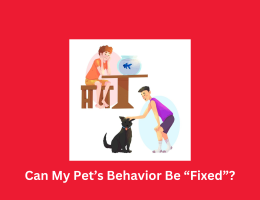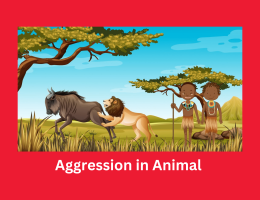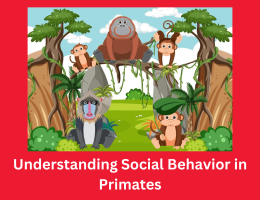
Aggression in Animal Groups: Exploring Influencing Factors and Behavioral Dynamics
- By admin --
- Tuesday, 12 Mar, 2024
Aggression is a ubiquitous phenomenon in animal behavior, often arising within social groups due to competition for resources, mating opportunities, and social status. Understanding the factors influencing aggressive behavior in animal groups provides valuable insights into the ecological dynamics of populations, the evolution of social structures, and the adaptive significance of aggression in shaping individual fitness and reproductive success.
Competition for resources is a primary driver of aggression in animal groups, as individuals strive to acquire essential resources such as food, water, shelter, and territory. Limited availability of resources relative to group size can lead to intense competition, triggering aggressive interactions among individuals. Intraspecific competition for resources is particularly pronounced in environments where resources are spatially or temporally limited, such as during periods of drought, food scarcity, or overcrowding.
Another important element influencing violent behavior in animal groups is the availability of mating chances, particularly for males vying for access to females. In animals exhibiting polygynous mating systems, there can be fierce competition for reproductive opportunities whereby males mate with many females; thus, this might lead to heightened hostility and dominance contests. Such contests could involve anything ranging from verbal exchanges between males to wrestling matches among them; but they also include behaviors, like posturing in front of adversaries with an intention of intimidating them as well as attracting females would be mates.
Aggressiveness patterns in animal communities depend heavily on social status and dominance hierarchies because higher-ranking individuals often control resources, sexual opportunities, and social contact. By establishing ways of resolving disputes and sharing scarce resources in the community, dominance orders decrease both the frequency as well as the intensity of conflicts between members of these groups.
In order to avoid conflicts, subdued individuals result to submissive behaviors or other reproductive ways as dominant individuals typically access resources and mates of their choice.
Aggression in animal groups can be impacted by a wide range of variables, including as territorial defense, parental care, kin selection, and environmental stresses, in addition to resource rivalry, mating chances, and social standing.An animal when protecting its territory, nesting or feeding place from other animals usually ends up using violence. Much of this time such behavior may be directed toward potential offspring who may come out of breeding period but still need care or towards partner.
According to the notion of kin selection, people may act kindly or cooperatively toward members of their own genetic kinship, even if it means jeopardizing their own life or ability to procreate. Given the inclusive fitness advantages of kin-directed behaviors, several animal communities have developed a policy of protecting kin members while directing antagonism against unrelated individuals.
Cooperative breeding systems, where non-breeding individuals assist in raising offspring, often involve complex social dynamics and varying degrees of aggression towards outsiders.
Predation danger, habitat disturbance, and climatic fluctuation are examples of environmental stressors that can affect patterns of hostility among animal groups. High levels of predator pressure can strengthen social cohesiveness and increase survival by encouraging defensive aggressiveness and cooperative anti-predator activities. On the other hand, environmental disruptions like habitat loss, resource depletion, or climate variations can intensify competition for scarce resources, resulting in a rise in social instability and aggressiveness within communities.
A complex interplay of genetic, hormonal, physiological, and social variables influences how aggressive behavior manifests itself in animal communities. In many species, hormones like testosterone and cortisol are important in controlling violent behavior because they affect aggressiveness thresholds, dominance status, and territoriality. As people watch, copy, and adjust to the aggressive tactics of conspecifics, social learning and cultural transmission of aggressive behaviors also play a role in the emergence and maintenance of aggressiveness within groups.
Selective factors affecting individual fitness and reproductive success have a molded the development of violence among animal groupings. By providing benefits in resource acquisition, territory defense, and mate acquisition, aggressive behaviors can boost an individual's chances of successful reproduction and survival. Aggression does, however, come with a price, including energy consumption, the possibility of damage, social conflict, and possible suppression of reproduction. For this reason, the advantages and disadvantages of aggressive behavior must be balanced in various ecological circumstances.
The management of conflicts among wildlife and human hobby, the renovation of natural ecosystems and ecological integrity, and the reduction of anthropogenic stresses impacting animal populations are many of the conservation implications of animal institution aggressiveness. Strategies for decreasing human-wildlife conflicts encompass restoring natural habitats, employing warfare resolution techniques, and launching public schooling campaigns that sell cohabitation and decrease bad encounters between people and flora and fauna.
In conclusion, Animal group hostility is a complex phenomena that is impacted by social position, environmental conditions, competition for resources, and chances for mating. Researchers can obtain important insights into the adaptive relevance of aggressiveness in forming individual fitness, social dynamics, and population ecology by clarifying the mechanisms affecting aggressive behavior within animal groups. In a swiftly altering planet, it is important to understand animal grouping meanness from an ecological and evolutionary angle if we are to manage wildlife populations, foster human-animal co-existence and inform conservation measures.





